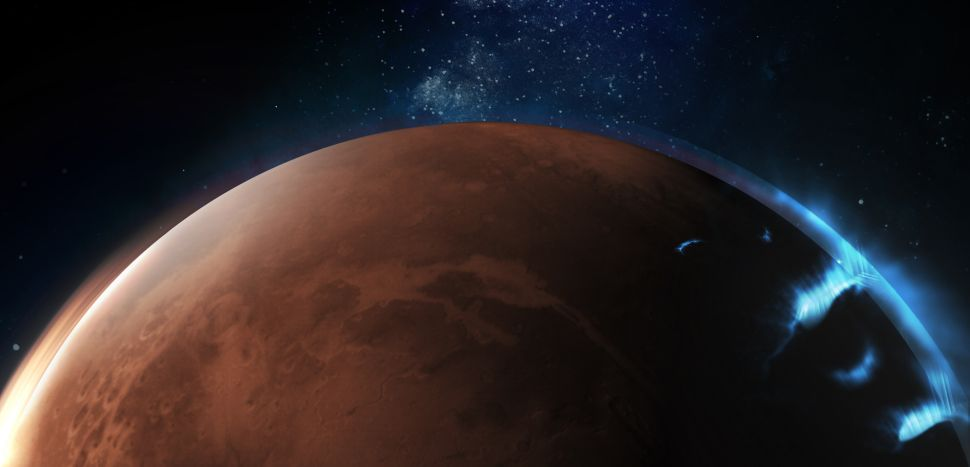Science & Technology
Discrete Auroras of Mars
- 06 Jul 2021
- 6 min read
Why in News
Recently, the UAE’s Hope spacecraft has captured images of glowing atmospheric lights in the Mars night sky, known as discrete auroras.
- The Hope Probe, the Arab world’s first mission to Mars, took off from Earth in July 2020, and has been orbiting the Red Planet (Mars) since February 2021. It is expected to create the first complete portrait of the planet’s atmosphere.
Key Points
- Auroras:
- An Aurora is a display of light in the sky predominantly seen in the high latitude regions (Arctic and Antarctic). It is also known as a Polar light.
- They commonly occur at high northern and southern latitudes, less frequent at mid-latitudes, and seldom seen near the equator.
- While usually a milky greenish color, auroras can also show red, blue, violet, pink, and white. These colors appear in a variety of continuously changing shapes.
- Auroras are not just something that happens on Earth. If a planet has an atmosphere and magnetic field, they probably have auroras.
- Cause of Auroras on Earth:
- Auroras are caused when charged particles ejected from the Sun’s surface - called the solar wind - enter the Earth’s atmosphere.
- The typical aurora is caused by collisions between charged particles from space with the oxygen and nitrogen in Earth’s upper atmosphere.
- The electrons - which come from the Earth’s magnetosphere, the region of space controlled by Earth’s magnetic field - transfer their energy to the oxygen and nitrogen atoms and molecules, making them “excited”.
- When a large number of electrons come from the magnetosphere to bombard the atmosphere, the oxygen and nitrogen can emit enough light for the eye to detect, giving us beautiful auroral displays.
- In the northern part of our globe, the polar lights are called aurora borealis or Northern Lights, and are seen from the US (Alaska), Canada, Iceland, Greenland, Norway, Sweden and Finland.
- In the south, they are called aurora australis or southern lights, and are visible from high latitudes in Antarctica, Chile, Argentina, New Zealand and Australia.
- Discrete Auroras of Mars:
- Unlike auroras on Earth, which are seen only near the north and south poles, Discrete Auroras (DA) on Mars are seen all around the planet at night time.
- These DAs are traced out where energetic particles excite the atmosphere after being funneled down by a patchy network of crustal magnetic fields that originate from minerals on the surface of Mars.
- Martian Auroras are Different:
- Unlike Earth, which has a strong magnetic field, the Martian magnetic field has largely died out. This is because the molten iron at the interior of the planet - which produces magnetism - has cooled.
- However, the Martian crust, which hardened billions of years ago when the magnetic field still existed, retains some magnetism.
- So, in contrast with Earth, which acts like one single bar magnet, magnetism on Mars is unevenly distributed, with fields strewn across the planet and differing in direction and strength.
- These disjointed fields channel the solar wind to different parts of the Martian atmosphere, creating “discrete” auroras over the entire surface of the planet as charged particles interact with atoms and molecules in the sky– as they do on Earth.
- Significance:
- Studying Martian auroras is important for scientists, for it can offer clues as to why the Red Planet lost its magnetic field and thick atmosphere– among the essential requirements for sustaining life.
- With the information gathered during the UAE’s Mars mission, scientists will have a better understanding of the climate dynamics of different layers of Mars’ atmosphere.
Other Mars Missions
- NASA's Mars 2020 Mission (Perseverance Rover): The mission is designed to better understand the geology of Mars and seek signs of ancient life.
- Tianwen-1: China's Mars Mission: It was launched in 2019 to conduct scientific investigations into the planet’s soil, geological structure, environment, atmosphere and water.
- India’s Mars Orbiter Mission (MOM) or Mangalyaan: It was launched from the Satish Dhawan Space Centre in Andhra Pradesh by Indian Space Research Organisation in November 2013.







